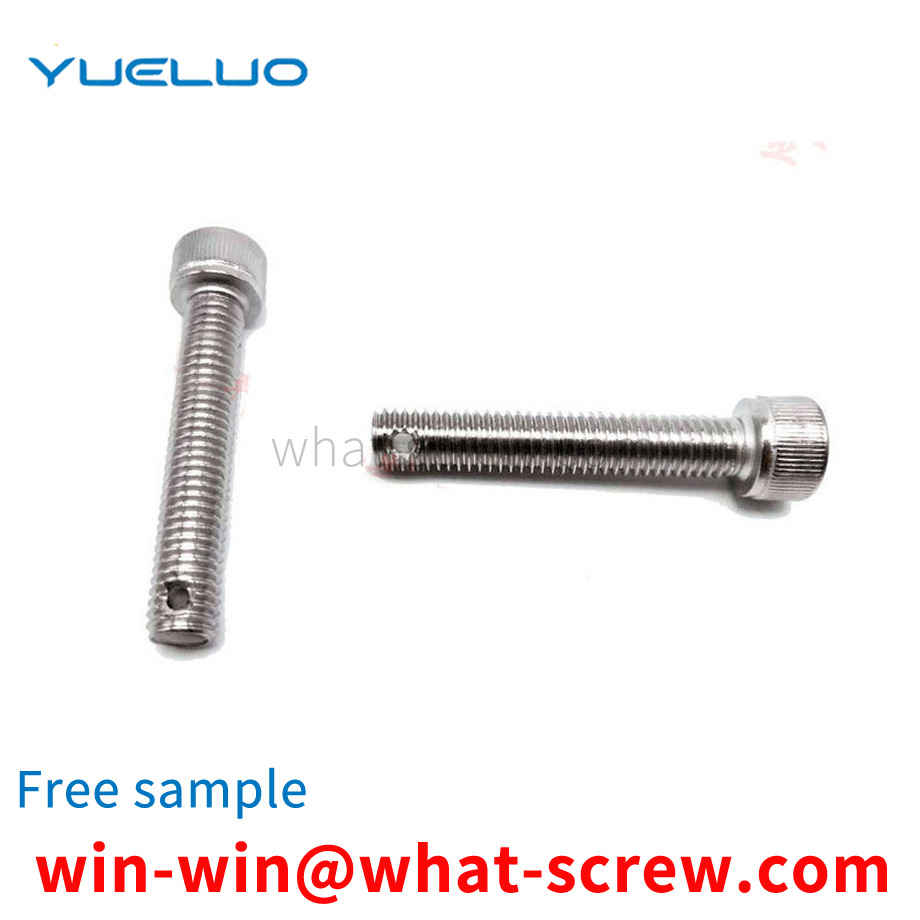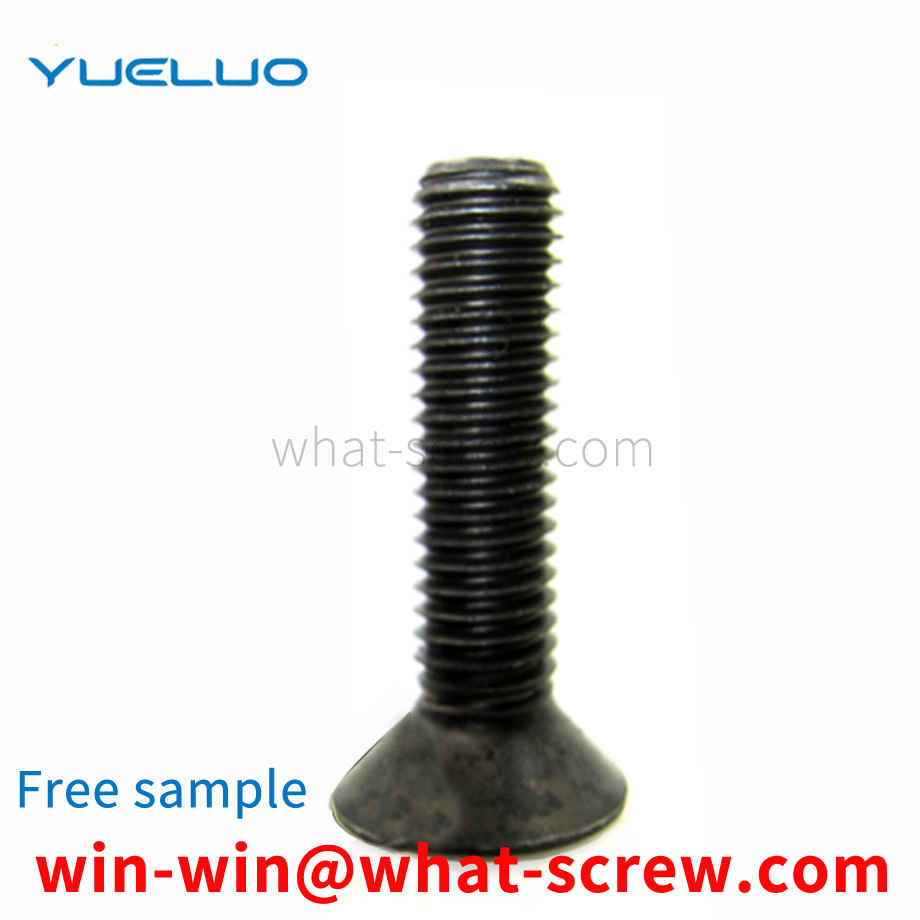screw is a tool that uses the physical and mathematical principles of the circular rotation and friction of an object to fasten the mechanism of the object step by step. A screw is a common term for fasteners, an everyday colloquial language. Screws are indispensable industrial necessities in daily life: tiny screws used in cameras, glasses, clocks, electronics, etc.; general screws in televisions, electrical products, musical instruments, furniture, etc.; as for engineering, construction, and bridges, large screws are used. Screws and nuts; transportation equipment, airplanes, trams, automobiles, etc. are used together with large and small screws. Screws have important tasks in industry. As long as there is industry on earth, the function of screws will always be important. The screw is a common invention in people's production and life for thousands of years. According to the application field, it is the first invention of mankind.
Stud bolts are manufactured in accordance with GB897-GB901 standards, the materials used are: Q235, 45#, 40Cr, 35CrMoA, Q345D, the specifications are: M3mm-M100mm, and the length can be customized according to user needs. High strength stud bolts, materials are 35#, 45#, 35CrMoA, 25Cr2MoV, 304, 316, 304L, 316L, 2H, 2HM, B7, B7M, B16, B8, 8, B8M, 8M, widely used in electric power, chemical industry , oil refining, valves, railways, bridges, steel structures, automobile and motorcycle accessories and other fields: generally used in mining machinery, bridges, automobiles, motorcycles, boiler steel structures, pendant towers, long-span steel structures and large buildings, etc. . Representation method of stud bolts: General stud bolts are expressed as: M12×100 GB 901-88 (standard) 35#/35# (material) 8.8 grade/8 grade (modulation grade) means: diameter = 12mm length = 100mm GB 901-88 adopts the national standard (of course, the industry standard can also be used as needed) stud bolt standard: GB 900-1988 Introduction to stud bolts Stud bolts save time and cost All stud bolt structures do not require drilling, Steps such as punching, threading, riveting, threading and finishing continue to expand the application potential of structural design, high current and small penetration. Therefore, welding to very thin sheets is possible. The workpiece for stud welding must be welded from one side. Can be soldered in all positions, with the help of extenders on vertical bulkheads that can be restricted. Since it is welded for a short time and there is little deformation after welding, no trimming is required. Because the welded structure does not require drilling, there is no leakage. The joint can achieve high strength, that is, the joint strength of stud welding is greater than the strength of the stud itself. How to install studs Good economy The advantage of other welding methods is the welding power. For mass-produced workpieces, standard studs are low cost. There are various types of equipment and welding torches, and the acquisition cost of equipment is relatively low. According to the product, it can be made into a multi-station automatic welding machine, or a high-precision gantry-type CNC automatic welding machine. Stud welding has high quality reproducibility and low rejection rate. However, in the application of stud welding, it should be noted that, like other fusion welding, there are certain restrictions on the carbon content in the steel. For structural steel studs, welding should be performed according to the recommended combination of stud material and base metal. There will be infusibility with the base metal. Combinations of stud material and base metal outside the recommended range shall be tested to determine the weldability and the product design requirements of the anchor bolt for the possibility of relevant inspection and evaluation.
The drawing process has two purposes, one is to modify the size of the raw materials; the other is to obtain basic mechanical properties of the fasteners through deformation and strengthening. For medium carbon steel, medium carbon alloy steel also has another purpose, that is, to make the wire rod. The flaky cementite obtained after controlled cooling is cracked as much as possible during the drawing process to prepare for the subsequent spheroidization (softening) annealing to obtain granular cementite. However, some manufacturers arbitrarily reduce the drawing in order to reduce costs. The excessive reduction rate increases the work hardening tendency of the wire rod, which directly affects the cold heading performance of the wire rod. If the distribution of the reduction ratio of each pass is not appropriate, it will also cause torsional cracks in the wire rod during the drawing process. In addition, if the lubrication is not good during the drawing process, it can also cause regular transverse cracks in the cold drawn wire rod. The tangential direction of the wire rod and the wire drawing die is not concentric at the same time when the wire rod is rolled out of the die, which will cause the wear of the unilateral hole pattern of the wire drawing die to aggravate, make the inner hole out of round, and cause uneven drawing deformation in the circumferential direction of the wire. The roundness of the steel wire is out of tolerance, and the cross-sectional stress of the steel wire is not uniform during the cold heading process, which affects the cold heading pass rate. During the drawing process of the wire rod, the excessive surface reduction ratio will deteriorate the surface quality of the steel wire, while the too low surface reduction ratio is not conducive to the crushing of the flaky cementite, and it is difficult to obtain as much granular cementite as possible. , that is, the spheroidization rate of cementite is low, which is extremely unfavorable to the cold heading performance of the steel wire. For the bar and wire rod produced by the drawing method, the partial surface reduction rate is directly controlled within the range of 10%-15%.
Generally, the T-bolt structure is common, and its blank shape can be completed at one time on a multi-station cold heading machine. But for T-bolts with relatively rare structures, (for example: the intersection of ¢14x42 cylinder (head) + ¢12 cylinder, the two cylinders form a 90° intersection) due to the special structure, the head Cold forming is difficult, and the traditional processing route is: die casting blank → deburring → turning processing → grinding blank diameter → wire rolling → heat treatment → surface treatment → finished product packaging.
pin fixing device, comprising fastening bolts for processing and fixing two workpieces, wherein the pin fixing device further comprises a fixing groove arranged on the workpiece, a positioning hole which is arranged on the workpiece and communicated with the fixing groove, and a positioning hole is arranged in the positioning hole A pin is provided with a pin bushing, the pin bushing is sleeved on the positioning pin, an accommodation space is provided between the pin bushing and the inner wall of the fixing groove, and colloid is filled in the accommodation space. The use of the pin fixing device of Guangdong Yueluo Hardware Industry Co., Ltd. can greatly improve the positioning accuracy of the pin, improve the processing efficiency, reduce the manufacturing cost, testing cost and labor cost, with strong mobility and quick response.
We have many years of experience in the production and sales of screws, nuts, flat washers, etc. The main products are: bakelite handwheels, carbon steel grade 12.9 screws, core-strike expansion bolts, 201 stainless steel nuts and other products, we can provide you with suitable fastening products piece solution.



















 Service Hotline
Service Hotline




